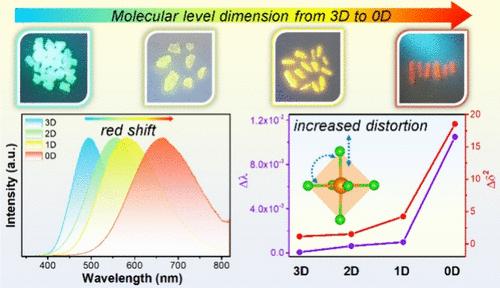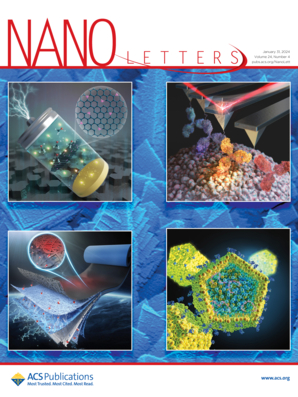开启全光谱光辉:无铅金属卤化物的尺寸调节,实现卓越的光致发光性能
IF 9.6
1区 材料科学
Q1 CHEMISTRY, MULTIDISCIPLINARY
引用次数: 0
摘要
具有可调结构的无铅金属卤化物已成为一类新型光电材料。金属卤化物多面体的排列决定了它们的结构尺寸,也是影响其光学特性的关键因素。为了研究这一点,我们合成了四种不同的掺杂锑(Sb)的铟(In)基金属卤化物,它们都具有零维(0D)电子结构,但在分子水平上表现出三维、二维、一维和 0D 结构维度。随着结构维度的降低,它们的自俘获激子(STE)发射出现了红移,峰值位置从 496 纳米升至 663 纳米。我们发现,随着结构维度的降低,[SbCl6]3- 八面体的畸变增加,导致 STE 能级降低和相应的红移,从而引起了红移。可调节的 STE 发射使这些金属卤化物有望用于防伪和白光 LED 应用。这些发现为调整无铅金属卤化物的 STE 发射提供了一种新策略。本文章由计算机程序翻译,如有差异,请以英文原文为准。

Unlocking Full-Spectrum Brilliance: Dimensional Regulation in Lead-Free Metal Halides for Superior Photoluminescence
Lead-free metal halides with tunable structures have emerged as a new class of optoelectronic materials. The arrangement of metal halide polyhedra defines their structural dimensionality and serves as a key factor influencing their optical properties. To investigate this, we synthesized four different antimony (Sb)-doped indium (In)-based metal halides, all of which possess zero-dimensional (0D) electronic structures but exhibit 3D, 2D, 1D, and 0D structural dimensionality at the molecular level. With a decreasing of structural dimensionality, their self-trapped exciton (STE) emission shows a red shift with peak position from 496 to 663 nm. We revealed that the red shift is caused by increased distortion of [SbCl6]3– octahedra as the structural dimensionality decreases, leading to lowered energy levels of STE and a corresponding red shift. The tunable STE emission makes these metal halides promising for anticounterfeiting and white LED applications. These findings provide a new strategy for tuning STE emission in lead-free metal halides.
求助全文
通过发布文献求助,成功后即可免费获取论文全文。
去求助
来源期刊

Nano Letters
工程技术-材料科学:综合
CiteScore
16.80
自引率
2.80%
发文量
1182
审稿时长
1.4 months
期刊介绍:
Nano Letters serves as a dynamic platform for promptly disseminating original results in fundamental, applied, and emerging research across all facets of nanoscience and nanotechnology. A pivotal criterion for inclusion within Nano Letters is the convergence of at least two different areas or disciplines, ensuring a rich interdisciplinary scope. The journal is dedicated to fostering exploration in diverse areas, including:
- Experimental and theoretical findings on physical, chemical, and biological phenomena at the nanoscale
- Synthesis, characterization, and processing of organic, inorganic, polymer, and hybrid nanomaterials through physical, chemical, and biological methodologies
- Modeling and simulation of synthetic, assembly, and interaction processes
- Realization of integrated nanostructures and nano-engineered devices exhibiting advanced performance
- Applications of nanoscale materials in living and environmental systems
Nano Letters is committed to advancing and showcasing groundbreaking research that intersects various domains, fostering innovation and collaboration in the ever-evolving field of nanoscience and nanotechnology.
 求助内容:
求助内容: 应助结果提醒方式:
应助结果提醒方式:


